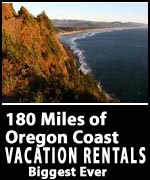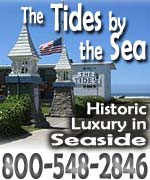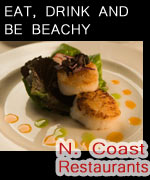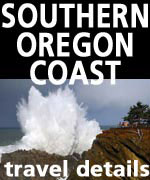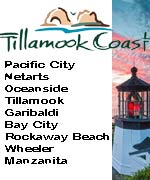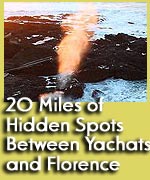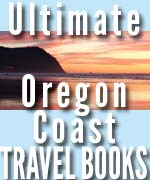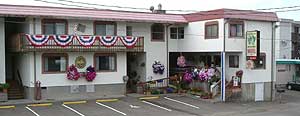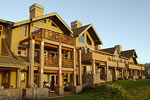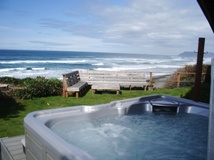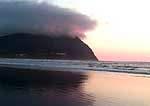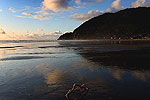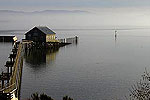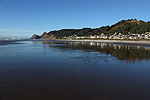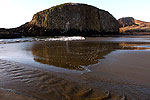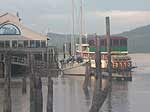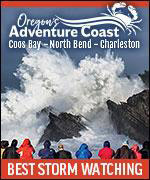 |
CONTACT / ADVERTISE ON BEACH CONNECTION
More Phenomenal Low Tides Coming to Oregon Coast |
|---|
Covering 180 miles of Oregon coast travel: Astoria, Seaside, Cannon Beach, Manzanita, Nehalem, Wheeler, Rockaway, Garibaldi, Tillamook, Oceanside, Pacific City, Lincoln City, Depoe Bay, Newport, Waldport, Yachats & Florence.
06/12/08
Secrets of the Season |
More Phenomenal Low Tides Coming to Oregon Coast
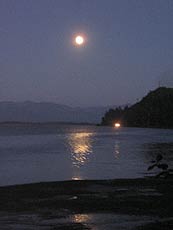 |
| The moon and the currents will be creating some extremely low minus tides in the coming months (pictured: Tillamook Bay) |
(Oregon Coast) - The central and southern coast had some of the lowest minus tides in a while recently, but more are on tap for the coming summer months for both the central and northern coast.
In fact, the north coast and the central Oregon coast will see even more impressive minus tides in July.
Last week, parts of the central coast saw minus tides as low as 2.7 feet on a couple days, the lowest of the year. The north coast’s day in the sun is still coming, said Tiffany Boothe, with Seaside Aquarium.
"We’ve got a few minus one-foot tides coming in July and August, and a minus two-foot tide in early July," Boothe said. "Especially in the first few days of July, there's some big ones coming."
This, of course, depends on the area of the coast you’re talking about. Lincoln City and other parts of the central coast will see a minus two-foot tide on July 3. The first few days of July will bring minus tides at a foot or nearly a foot.
"Last year, we only saw minus tides as low as minus 1.8 feet," Boothe said.
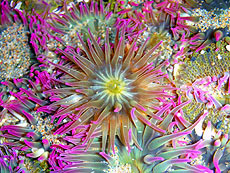 |
| Tidepool wonders will burst into life at the coming minus tides (photo Tiffany Boothe, Seaside Aquarium) |
The central coast will see more minus tides around one foot lower than usual from August 1 through 4.
"There are still some pretty low tides, like .8 or minus .7 - a lot of those in the next two months," Boothe said.
Check www.oregoncoasttidetables.com for more on those.
Boothe said places like Haystack Rock in Cannon Beach will yield lots of wonders at such minus tides.
Other spots to look for are Oceanside, where you may gain access to the hidden beach on the side of Maxwell Point simply by walking around the point, instead of walking through the tunnel.
Sometimes, there are hidden caves found from the northern part of this shoreline at such minus tides, accessed from Short Beach (which is about a mile north of Oceanside along the Three Cape Loop).
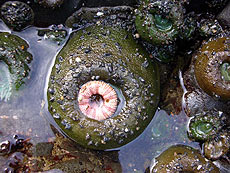 |
| Wacky tidepool creatures at Short Sand Beach, near Cannon Beach (photo Tiffany Boothe, Seaside Aquarium) |
Tides could well be low enough to gain access to the interior of the Devil’s Punchbowl, if you’re coming from the northern side of the beach, at the entrance to the marine gardens. This is especially stunning as you can see all sorts of strange colors and the patterns of erosion caused by the usually manic tide in this spot.
However, keep a close eye on the tide and do not attempt to venture into these places if the waves are lapping at your route or the entrance of these wild oddities.
Boothe said in Seaside you can head toward the south end of town to the cove. There, you will find small tide pools down by the rocks. Expect to find hermit crabs, shore crabs, snails, sea anemones, sea stars, and a variety of shells.
To the north, closer to the river mouth, sand dollars should be plentiful, but be careful to not take the live sand dollars.
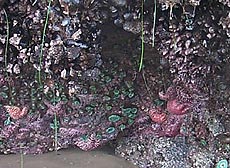 |
| Marine creatures emerge en masse at Oceanside |
“An easy way to tell if a sand dollar is alive or not is to see if it has ‘fur,’ “ Boothe said. “Sand dollars that appear fuzzy on the underside are usually still alive and will stink something awful when taken home.”
Further south in Cannon Beach, the tide pools get a little livelier and you may find a beautifully colored 20-ray sea star, various species of nudibranchs, larger telia anemones, and sea urchins, or you may even spot a seal or two.
“As you go further south Arcadia, Hug Point, and Arch Cape, expect to find some the same,” Boothe said. “If you can find more protected intertidal areas, look out for California and burrowing sea cucumbers, rock scallops, lewis moon snails, kelp and decorator crabs. Watch out for the red rock crabs though - they'll get ya. During these low tides you may see some leather stars or blood stars, brightly colored tide pool sculpins, and an assortment of shrimp. During one tidal expedition in the Oswald West area, we even spotted a giant pacific octopus by far the coolest tidal find.
 |
| Inside Devil's Punchbowl during a minus tide, near Newport |
“This is just the tip of the iceberg, so to speak. An avid tide pooler may notice other things during these low tides, such as the different colors and species of sponge ranging from bright yellow, red, green, and purple, or aciadians which often wash up in clumps during winter storms. I mention both sea urchins and sea anemones but one might take time to notice the different species.”
Boothe said if the surf is calm, you may be able to see a few different types of fish.
“Perch are really common,” she said. “Kelp greenling, small Cabizon. In the tide pools, typically you'll find various sculpins, but a very lucky and sneaky observer may see a kelp fish or an Irish Lord.”
Boothe offered some advice for these kind of tide pool explorations.
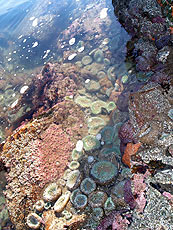 |
| Tide pool discoveries show up at Arcacia State Park, just south of Cannon Beach (photo Tiffany Boothe, Seaside Aquarium) |
“One thing I suggest highly is to get a Mac's Field Guide or another tide pool reference to take it with you,” she said. “You might come across something you can't identify, or worse you may over look an animal you didn't know existed, like a gumboot chiton.”
Always be aware of the tide a never turn you back to the ocean, Boothe stressed. The best time to go tide pooling is about two hours before low tide. This usually provides plenty of time to explore and be safe.
“Don't rush,” she said. “Intertidal areas are so exciting one might rush by tide pools and not see what's really in there. Some animals hunker down and hide if a shadow passes by - so be patient.”
Boothe also said taking a binocular and a camera is highly suggested.
 |
|
Tradewinds Motel, Rockaway Beach. All rooms are immaculate and have TV’s, VCR’s and in-room phones w/ data ports. Oceanfronts have queen bed, a double hide-a-bed, kitchen, cozy firelog fireplace and private deck. Both types sleep up to four people. Others are appointed for a two-person romantic getaway, yet still perfect for those on a budget. Elaborate oceanfront Jacuzzi suite has two bedrooms, kitchen, double hide-a-bed, fireplace and private deck, sleeping as many as six. For family reunions or large gatherings such as weddings, some rooms can connect to create two-room and three-room suites. Some rooms pet friendly. 523 N. Pacific St., Rockaway Beach. (503) 355-2112 - 1-800-824-0938. www.tradewinds-motel.com |
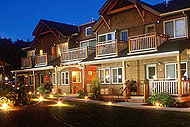 Inn
at Cannon Beach. Beautifully wooded natural setting at quiet south
end of Cannon Beach. Great during winter storms with a new book by
the fireplace – or when the sun is out for family fun and beach
strolling. Handsome beach cottage-style architecture. Lush flowering
gardens and naturalized courtyard pond. Warm, inviting guest rooms.
Continental buffet breakfast. Warm Cookies. Family and Pet Friendly.
Welcome gifts. Smoke-free. Complimentary Wireless Connectivity. Wine
and book signing events. 800-321-6304 or 503-436-9085. Hemlock At
Surfcrest, Cannon Beach, Oregon. www.atcannonbeach.com. Inn
at Cannon Beach. Beautifully wooded natural setting at quiet south
end of Cannon Beach. Great during winter storms with a new book by
the fireplace – or when the sun is out for family fun and beach
strolling. Handsome beach cottage-style architecture. Lush flowering
gardens and naturalized courtyard pond. Warm, inviting guest rooms.
Continental buffet breakfast. Warm Cookies. Family and Pet Friendly.
Welcome gifts. Smoke-free. Complimentary Wireless Connectivity. Wine
and book signing events. 800-321-6304 or 503-436-9085. Hemlock At
Surfcrest, Cannon Beach, Oregon. www.atcannonbeach.com. |
|
The Ocean Lodge. There will not be another property built like this in Cannon Beach in our lifetimes. Rare, premiere ocean front location; handsome, dramatic architecture and tasteful, fun (nostalgic) beach interiors. Overlooks Haystack Rock. 100 percent smoke free. Imaginative special occasion packages. Massive wood burning lobby fireplace. Library w/ fireplace, stocked with impressive book collection. Pet and family friendly. Lavish continental buffet breakfast. In-room fireplaces, mini-kitchens. Jacuzzi tubs in select rooms. DVD players, complimentary movies. Morning paper. Warm cookies. 888-777-4047. 503-436-2241. 2864 Pacific Street. Cannon Beach, Oregon. www.theoceanlodge.com |
|
Arch
Cape Property Services.
Dozens of homes in that dreamy,
rugged stretch between Cannon Beach and Manzanita known as Arch
Cape. Oceanfront and ocean view , or just a short walk from the
sea. |
RELATED STORIES
Click here for video of Dec. storm aftermath
Oregon Coast Best of Awards for the Year And the winners are: best of Oregon coast restaurants, lodgings, science, odd events in nature and stunning moments for 2007
Watching Transformations of Oregon Coast Beaches Seasons change and so do beaches, revealing different sides and a variety of eye-popping sights
Staggeringly Cool Ideas for Oregon Coast Romance Be it the season of Valentine's or be it any time of the year, Oregon's coastline has essentially cornered the market for cuddle-inducing possibilities and gushy activities for the hand-holding set
Day or Night Mysteries and Merriment on Oregon Coast It's more than just nightlife that comes to life, but the beaches offer major opportunities
Oregon Coast Travel Site Goes Wireless Provides Lodging Reports - Oregon Coast Beach Connection now has mobile lodging and dining listings, along with weekly lodging availability reports
|
Oregon coast mileage chart & map Day trips, suggested itineraries Search for Oregon Coast Subjects, Articles Oregon Coast Complete Guides every beach access, attraction |
|||||||||||||
OR
TAKE THE VIRTUAL TOUR |
|||||||||||||
|



